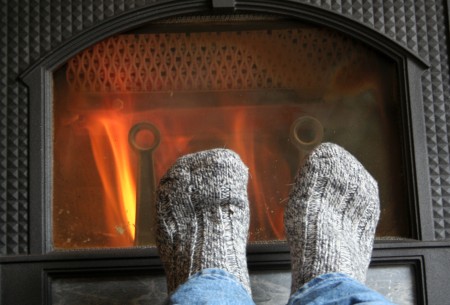
It started with a slightly scratchy throat on Christmas Eve.
I drove up to see a good friend who lives north of Louisville that day, and warned her as I stepped in the door that I was coming down with something and was probably contagious. She made me a cup of tea with honey, and that was the last I thought about being sick during our visit.
By Christmas night, the scratchy throat was joined by chest congestion, which is not the usual cold progression for me; normally a cold will start as sinus congestion first, then move down into my chest. This time I started coughing long before the sneezing and nose-blowing stage, which hit me full-force on Wednesday. It snowed that day, and I stayed close to the fire, crossing off all but the most necessary items from my daily to-do list, and bundling up well for pasture rounds.
By Thursday, my chest was aching and I could feel a deep congestion settling into my bronchial tubes, something I’ve not had in quite a long time. As an ex-smoker, I expect residual damage and weakness in that area, but since quitting 18 months ago I haven’t had any serious chest colds. This one would break that streak. But I didn’t know that yet, so Thursday afternoon I bundled up and got a little exercise, cutting up a downed sassafrass tree at the edge of one of the pastures, to add to my firewood stash.
My standard response to cold symptoms these days does not usually involve masking symptoms with pharmaceuticals. Mostly, I think, because I’m too cheap to spend the money on the stuff. Unless I’m aching so bad I can’t sleep, I won’t take pain killers; I really don’t like the way antihistamines artificially dry out the sinuses, and cough syrup that either inhibits or promotes expectorant just doesn’t make any sense to me. Granted, I don’t have to go to a workplace job and interact with other employees or the public, so the snottier aspects of being sick are just between me and my kerchief.
Other than common sense measures like keeping my head and feet warm, drinking lots of liquids, and slowing down to let my body fight the bug, the only additional support I employ is a high-dosage of vitamin C powder dissolved in water, taken throughout the day. I have found this helps my body’s response efforts and shortens the duration of the cold. I’ve never done a double-blind study to prove any beneficial effects, but it’s cheap and non-toxic and I figure it can’t hurt.
The major drawback to not masking symptoms with drugs, though, is you have to experience the symptoms. But they don’t last forever, and my colds move through me much quicker now that I’m not inhaling smoke and toxins on a daily basis. And usually I don’t find the “I’m sick” stuff – the sneezing, nose-blowing, coughing – to be overwhelmingly decapacitating, just annoying. But the chest congestion that came with this cold, I swear it nearly killed me Thursday night.
I will spare you the phlegmy details, but suffice it to say, I didn’t sleep much and thought a couple of times I needed to be intubated just to keep breathing. Heavy stuff. Worst crap I’ve had in my bronchi in a long, long time. Kind of scared me, actually, the not being able to breathe part. So yesterday I took another sick day, and crossed the project of spreading gravel with the tractor up on the hill before it rained off my list, and stayed close to the woodstove all day. It was crappy weather, mid-thirties, spitting rain: I didn’t need to push myself any further toward the cliff edge.
So today, I feel much better, and the congestion is loosening and lightening, and my energy is back. I’m recovering. I warm my tootsies in front of the stove every time I come back in from pasture rounds, I wear a hat every time I step outside even if it’s just to take the dogs out for a pee break, and for one more day, I left the extra outside projects off my list.
They will get done in due time. I’d rather be getting better and be behind on my winter projects, than the other way around.
Read Full Post »







